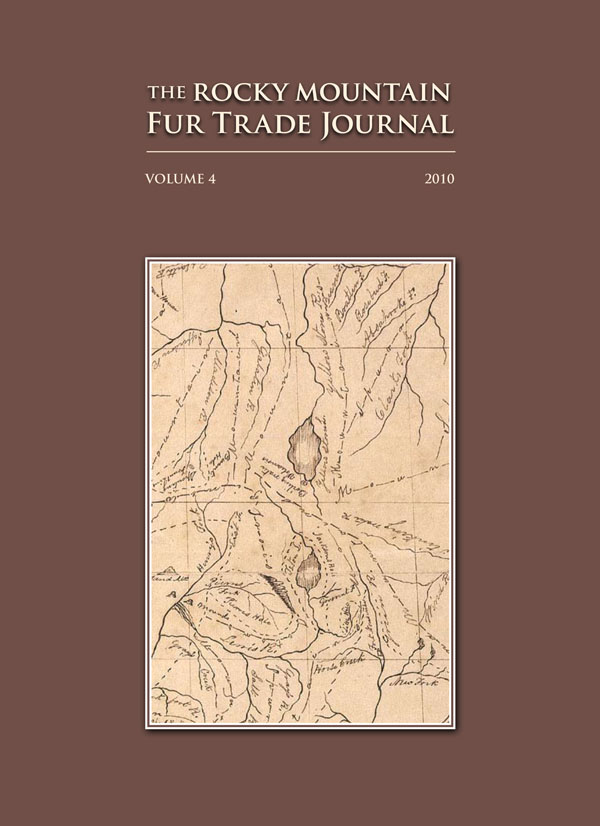$19.95
2010 Rocky Mountain Fur Trade Journal, Volume 4
An annual academic peer-reviewed publication intended to further the knowledge and discussion of the Rocky Mountain fur trade era and provide an avenue for researchers to showcase their work.
Full color, perfect bound, 8″ x 11″, softback, 150 pages
ISSN: 1937-0733
Journal is provided FREE with a purchase of an annual membership!!! Click here to purchase a membership now!
Description
2010 Rocky Mountain Fur Trade Journal, Volume 4
Was Meriwether Lewis the Godfather of the Rocky Mountain Fur Trade?
by Thomas C. Danisi and John C. Jackson
The article investigates the impact Meriwether Lewis had on the early foundation of the fur trade. It examines the role Lewis played in the initial years following the return of the Corps of Discovery from its epic exploration of the newly acquired Louisiana Territory. It is said that Lewis’s outspoken viewpoints on commerce were instrumental in birthing the hunt for beaver pelts in the West.
Going Indian! The Use of Leggings and Breech Clout by the Euro-American Trapper of the Rocky Mountains
by Clay Landry
The examination of fur trade material culture is the topic of this article. Clay Landry makes extensive use of primary sources to describe types of legwear worn by men of the fur trade. Whether trappers wore breech clout and leggings has long been debated among material culturists. Landry’s in-depth consideration of the matter provides a critical assessment and a well-defended conclusion that should lay this question to rest, once and for all.
Union Pass: A ‘Mountain of Many Waters’
by Stephen V. Banks
Just how well Union Pass was known to Rocky Mountain trappers is the subject of this article by Stephen V. Banks, long known for familiarity with that particular geographical area. Bank’s knowledge of local Indian lore, supplemented by period journals and diaries, documents repeated use of this pass and what made it beneficial to travelers.
Painting the Rocky Mountain Fur Trade: An Artist Creates On the Headwaters of Spanish River
by Tim V. Tanner
Professional artist Tim V. Tanner explains in this article the process he used to create a historically accurate work of art. Tanner painted the work specifically for this article and readers will undoubtedly appreciate how much research went into its details. Tanner, who makes his living instructing as well as producing art in a variety of media, provides a unique opportunity for artist and non-artist alike to grasp the effort that goes into a period piece.
Warren Ferris, the Hudson’s Bay Company, and the Rendezvous of 1834
by Scott Walker
Scott Walker investigates Ferris’s role as a trader, rather than trapper, during the Joint Occupancy of the Oregon Territory, and how an American selling HBC goods affected the HBC’s own interest in the rendezvous system. Research in the HBC archives led Walker to the invoice of goods Ferris took to rendezvous, providing unique insight into fur trade material culture.
Wheels to Rendezvous
by E. Rick Williams
Caravans of pack mules brought many goods to the Rockies but wheeled vehicles played a greater role in opening the West. The fur trade brought the first wagons over the Continental Divide and proved that rolling to the Pacific was a possibility, a fact explored by E. Rick Williams the author of this article. Discussing wagons as transportation for people as well as freight, Williams spins an interesting tale that concludes with rendezvous supply routes opening the road for emigrants, and setting in motion the great migration of the 1840s-1850s.
Goggles in the Rocky Mountain West
by Alida Boorn
This article explores the early use of sunglasses. From fur trade records dating as far back as 1733, Alida Boorn shows how goggles shielded eyes for trappers, Native Americans, and overland travelers. A variety of primary documents from journals to newspaper advertisements bolsters this paper’s focus without shading how the function of sunglasses remains virtually unchanged today.
Sublette County Historical Society, 2010

